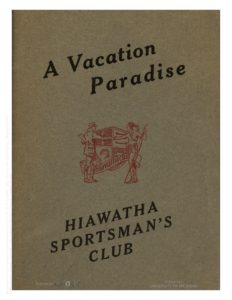Henry Wadsworth Longfellow published The Song of Hiawatha in 1855. The epic poem was an instant success. Newspapers published excerpts, authors copied its prose, playwrights adapted the story for the stage, and American children encountered the poem as an educational tool. More interesting, perhaps, was the way in which Longfellow’s prose appeared on the Michigan landscape. Streams, rivers, forests, hunting clubs, and towns carry the name of Hiawatha as well as other names of characters from Longfellow’s poem. Above all, the place names are associated with natural features found on the Michigan landscape. Michiganders named forests, rivers, and streams after the poem as way to romanticize the environment and give it a sense of place.

As Americans lamented the loss of natural spaces in the late-nineteenth and early twentieth centuries, the “Land Of Hiawatha” represented an untouched, pristine, and primitive natural world. As seen in this 1929 advertisement, the Land of Hiawatha was advertised as a site where white Americans vacationed, Indians acted like Indians, and the natural world was as untouched as the days of Hiawatha. This fictional paradise served as an imagined space for tourists, conservationists, and outdoor enthusiasts that hoped to connect with the natural world.

Using ArcGIS I have mapped all the places in Michigan that carry a name associated with the poem. By cross-referencing prominent character names and landscape references from the poem with various sources including the USGS Geographic Name Information System Database, I have created a map showcasing how literature has shaped the map of Michigan. By clicking on the blue points and orange blocks it is apparent that most of the place-names feature a natural feature whether stream, river, waterfall, or forest.
It is no surprise, then, that a majority of places named in honor of The Song of Hiawatha are found in the northern stretches of Michigan. The northern portion of the Lower Peninsula and the Upper Peninsula are far less populated than downstate population centers. Even today, thousands upon thousands of midwesterners pack their cars and head to “The Land of Hiawatha” each summer. They are searching for beautiful landscapes, a break from modernity, and the opportunity to watch a sunset on the shores of the Gitche Gumee.
Further Reading:
- Camden Burd, “Imagining a Pure Michigan Landscape: Advertisers, Tourists, and the Making of Michigan’s Northern Vacationlands,” The Michigan Historical Review 42.2 (Fall 2016): 31-51.
- Camden Burd, “In the Land of Hiawatha: Conservation and Literary Sociability in Michigan,” in Pieces of the Heartland: Representing Midwestern Places, edited by Andy Oler (Hastings, Nebraska: Hastings College Press, 2018), 23 – 38.
- Philip J. Deloria, Playing Indian (New Haven: Yale University Press, 1998).
- Jared Famer, On Zion’s Mount: Mormons, Indians, and the American Landscape (Cambridge: Harvard University Press, 2008).
- Chase S. Osborn and Stellanova Osborn, Schoolcraft, Longfellow, Hiawatha (Lancaster, Pennsylvania: The Jaques Cattell Press, 1942).
- Alan Trachetenberg, Shades of Hiawatha: Staging Indians, Making Americans, 1880-1930 (New York: Hill and Wang, 2004).
- Virgil J. Vogel, Indian Names in Michigan (Ann Arbor, Michigan: The University of Michigan Press, 1986).
Resources Used:
- Story Maps. Michigan cities and townships [map]. Scale Not Given. “Minor civil divisions from MiGDL, the Center for Geographic Information, State of Michigan.” August 2013. http://services.arcgis.com/nzS0F0zdNLvs7nc8/arcgis/rest/services/Michigan_cities_and_townships/FeatureServer/0. (January 10, 2017).
- ESRI DM. USA Maps [map]. Scale Not Given. “This layer presents National Parks, National Forests, State Parks, and State Forests within United States.” September 2016.http://services.arcgis.com/P3ePLMYs2RVChkJx/arcgis/rest/services/USA_Parks/FeatureServer/0. (January 10, 2017).
This project was made possible with technical support from Blair Tinker and the Digital Scholarship Lab at the University of Rochester.